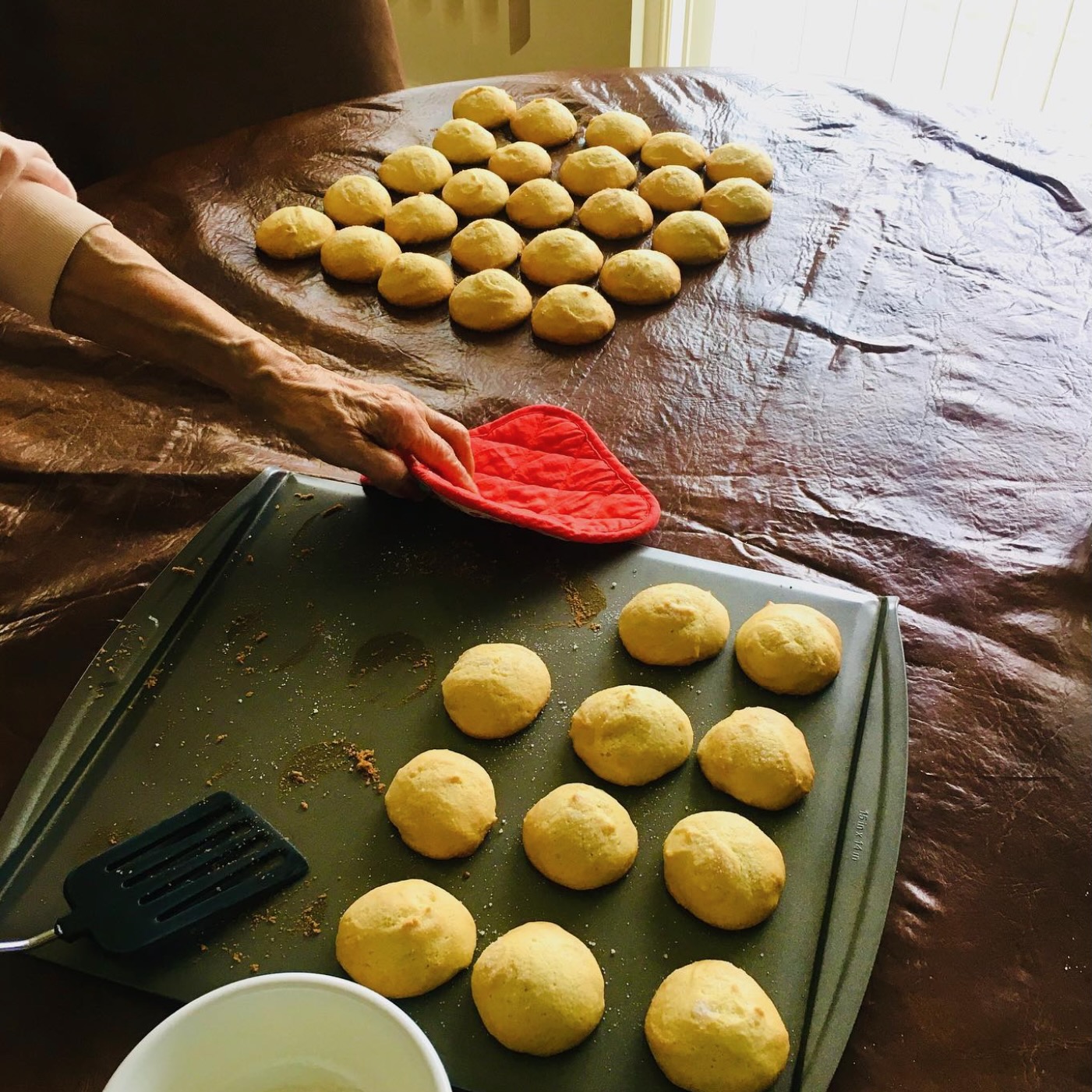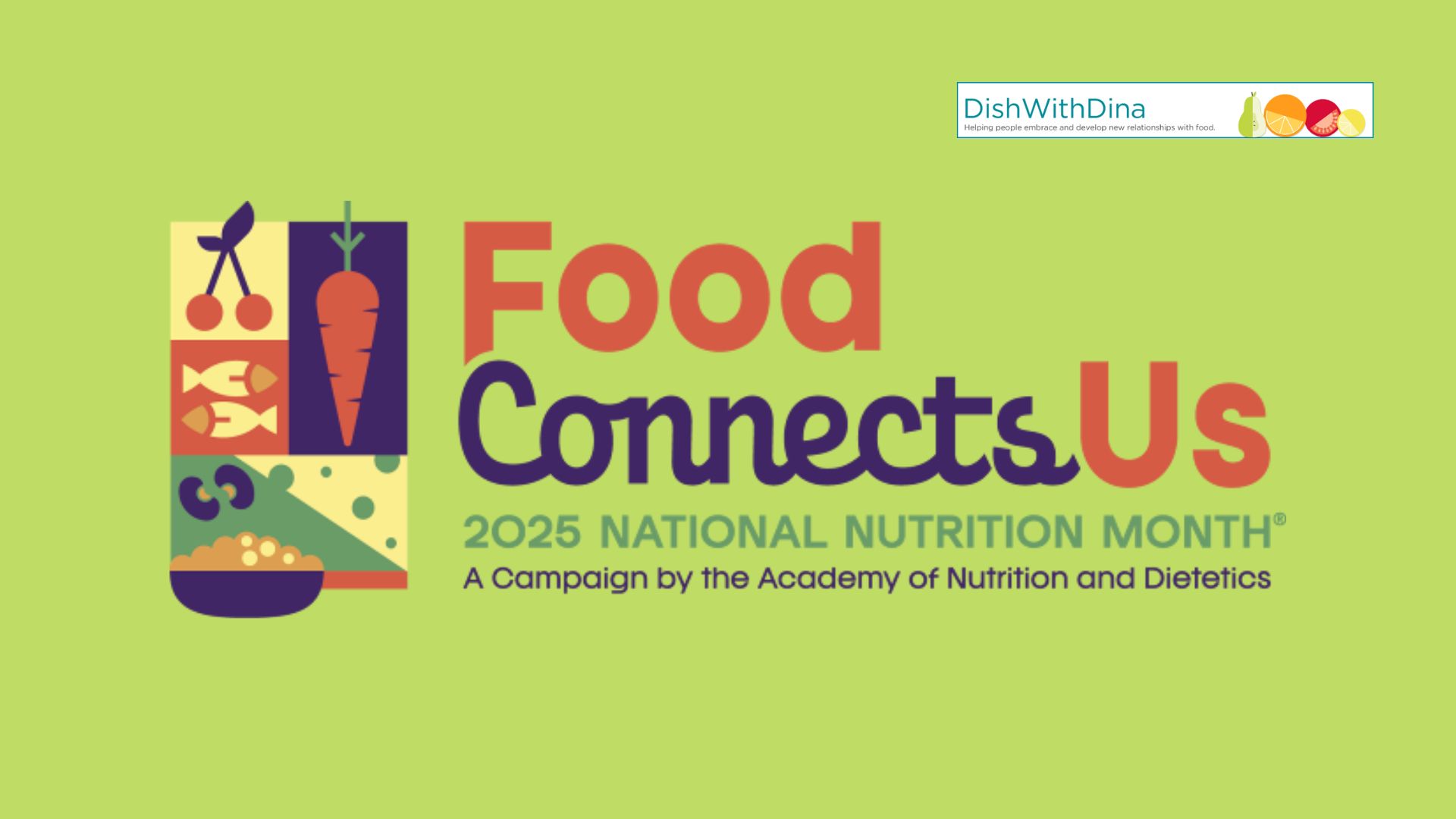Discover how food serves as a universal connector, bridging cultures, strengthening communities, and fostering relationships. Explore the multifaceted ways in which sharing meals enriches our lives.
This month, we come together to celebrate National Nutrition Month®, and this year’s theme focuses on how “Food Connects Us,” which beautifully encapsulates the profound role that food plays in bridging gaps, fostering relationships, and building communities. From family dinners to community potlucks, food has always been at the heart of human connection.
On the second Wednesday of every March, we also celebrate Registered Dietitian Nutritionist Day so you can only imagine how excited I am when this month rolls around! Registered Dietitians are known to be nutrition experts and provide services known as Medical Nutrition Therapy. We work with people who are either preventing, managing, or trying to slow the progression of a particular diagnosis and we coordinate both education and counseling into our interventions to help our patients become more confident and knowledgeable about all aspects of their conditions. (To learn more about what an RD is and does, click here to watch our webinar on collaborating with interdisciplinary team members.)
As always, whenever we discuss food an nutrition, we always want to recognize the social determinants of health and systemic inequalities that exist in the U.S., so please take whatever makes sense for you from what is shared below and in our content in general [1].
The Universal Role of Food in Human Connection
Food doesn’t magically appear on our plates; it has a journey that connects us to things like farmers, food suppliers, and even the environment (like picking fruits off of trees). We have a variety of places across the country that produce food and every ingredient tells a story. In our current lives, we might find ourselves leaning toward immediate gratification, and the go-go-go mentality of hustle culture. Instead, I challenge you to slow down, recognize, be respectful, and honor where our food comes from.
That connection helps us with deepening our appreciation for everything that goes on behind the scenes: the labor, the knowledge, the tradition…everything that is involved in producing our food also recognizing global trade which is connecting us to things that are not available locally (I’m speaking generally about the United States and more specifically about New York City, where I live), like bananas from Central America spices from India, seafood from the Pacific, just to name a few.
In New York State, there are nearly 32,000 family farms that produce food and beverages that are shared both locally and across the world. We also have a GrowNYC, a program that provides our residents with green markets across all five boroughs and tout products from local vendors and farmers. At these markets, we can find everything from fresh lavender to seasonal produce to honey. It’s such a cool feeling to be walking around the “concrete jungle” and then stumble across these markets that pull us in with their vibrant colors and intoxicating aromas.
The Cultural Significance of Food
Regardless of where you hail from—or if you have an immigrant family that has come from other places across the globe—think of how you connect with food, be it traditional dishes, how you celebrate milestone events or religious holidays. These gatherings allow us to express our cultural identity and preserve our family or community heritage.
I remember opening up recipe books that my mom had been handed down from my grandmother. Inside were handwritten notes on a greasy pieces of paper that were barely legible, but warmed my heart to think of the time when Nonna sat at her kitchen table and scribbled down her list of ingredients and instructions knowing that we would carry on her recipes for decades to come.

Think about things that make you feel connected to your culture: I recently signed up for a six-week culinary nutrition virtual series where we had dietitians from Venezuela, Hawaii, Germany, Japan, Afghanistan, and India present histories, health concerns, and recipes from their cultures. While I loved seeing how each region was represented, what struck me most was how there were so many more similarities than differences across the globe. One person’s arepa is another person’s dumpling; one person’s sauerkraut is another person’s kimchi; and so on.
What I also recognized was how many cultural food are vilified as “too fat” or “too salty” when, really, the bases of all of the meals represented in this series revolved around colorful plants, healthful cooking methods, and eating in a community setting. When I think of my school curriculum, I realize that we are really doing a disservice to these cultures by pushing the Mediterranean diet as the “gold standard”, when that doesn’t do justice to the black, brown, and other communities who have the ability to eat and make healthy meals in their our own way.
Food in Celebrations, Rituals, and Social Interactions
Food plays a role in social interactions and celebrations and serves a purpose in cultural touchstones by allowing different communities to honor their traditions, whether in a more intimate setting or at a larger gathering. These interactions build and bridge community ties and connections. People who engage with each other—a psychological benefit in sharing meals—can have conversations that dive a little bit deeper in recognizing their individuality and the parts they play as a whole [2]. Gathering and celebrating also reduces isolation and fosters a sense of belonging. The continuation of storytelling also helps with promoting understanding and empathy, and gets us to think outside the box, recognizing that we can find we have a lot more in common with each other. We can also create great memories and be able to look back on things and think about the smells and the conversations and the dishes we took part in.
Sharing meals offers more than just nourishment; it provides an opportunity to explore diverse cultures, traditions, and histories. Experimenting with various cuisines allows us to appreciate the rich tapestry of flavors and stories that define different communities. Embracing the chance to connect with others through food helps us broaden our horizons and deepen our understanding of one another.
Community Building Through Food Initiatives
Community gardens, farmers markets, food co-ops, and food programs have an impact that fosters social cohesion in every way from disease prevention and treatment to health equity to life cycle nutrition. Implementing something like breastfeeding in the workplace was originally spurred from a food initiative. Child nutrition reauthorization in the Women, Infants, and Children (WIC) programs helped provide supplemental food nutrition and support to children ages 0 to five [3]. Access to diabetes self-management training is also related to a food initiative as has the Farm Bill—which is not only about the what farmers grow but what is available for access in the United States’ food supply— as well licensing and credentialing healthcare and nutrition professionals like Registered Dietitians.
In New York City, Hunter College’s Food Policy Center keeps up with evidence-based solutions for diet-related diseases and promotes food security in our and other urban centers. We also have organizations like City Harvest, Meals on Wheels (which is also a national program), and Stellar Farmers Market that provide everything from food rescue and distribution to nutrition education the local community.
The Role of Food in Social Movements
Organizations like Slow Food create a global movement for individuals, producers, growers, farmers, chefs, and corporations to support and protect the planet. They also help create food biodiversity [4]. To clarify, right now, wheat, rice, and corn crops make up about 60% of global food production, but there used to be so many more available to produce and distribute. Sadly, about 75% of edible plant species have now become extinct due to factors like climate change and unsustainable or unstable financial practices. Much like how our gut needs diverse food, we want to make sure we’re not relying on the same simple ingredients over and over again, for the benefit of our planet as well as our health [5]. Slow Food is defending the diversity of plants (and animals) as is FoodTank, a global nonprofit community that works towards a positive transformation in how we both produce and also consume food. Its work with farmers, producers, policy makers, government leaders, and researchers is toward a mission of sustainable solutions for pressing environmental and social problems.
Practical Ways to Connect Through Food
One of the best ways to connect with food is to engage with local food sources directly. Consider visiting a farmers’ market to meet the people who grow your food. Don’t be shy! Ask questions about their farming practices and gain insight into seasonal eating. Community gardens offer opportunities to cultivate your own produce while fostering neighborhood connections. Even something as simple as reading food labels, researching brands, or learning about traditional food practices can bring a new level of awareness to the origins of your meals.
Understanding where our food comes from strengthens our relationship with what we eat, the people who produce it, and the cultures that influence our food choices. By making more informed and mindful decisions, we not only nourish ourselves but also contribute to a more connected and sustainable world. Take a look around your neighborhoods to find cultural communities or restaurants where you can experience the vibes and varieties of foods from around the globe. Here in NYC, we have places like Little Italy (both in the Bronx and in Manhattan), Little Odessa in Brighton Beach (Brooklyn) that has a rich Russian population, and Little Guyana along Liberty Ave in Richmond Hill (Queens).
If you don’t have the opportunity to be out and about, then look for new or different produce items in your supermarket. Try out something like jackfruit in your next recipe to open your mind and senses to a whole new world of flavors.
Our March 2025 Wellness Webinar on National Nutrition Month® will be made public in a few months on the DishWithDina YouTube channel; in the meantime, click below and check out last year’s discussion to learn more about where our food comes from, available community resources, and factors that influence our relationship with food.
References
- Healthy People 2030: Social Determinants of Health – https://odphp.health.gov/healthypeople/priority-areas/social-determinants-health
- WIC: USDA’s Special Supplemental Nutrition Program for Women, Infants, and Children – https://www.fns.usda.gov/wic
- Diet and Health Benefits Associated with In-Home Eating and Sharing Meals at Home: A Systematic Review – https://pmc.ncbi.nlm.nih.gov/articles/PMC7915304/
- Biodiversity: Sustainable, healthy food systems – https://www.who.int/news-room/fact-sheets/detail/biodiversity
- Influence of Foods and Nutrition on the Gut Microbiome and Implications for Intestinal Health – https://pmc.ncbi.nlm.nih.gov/articles/PMC9455721/



0 Comments